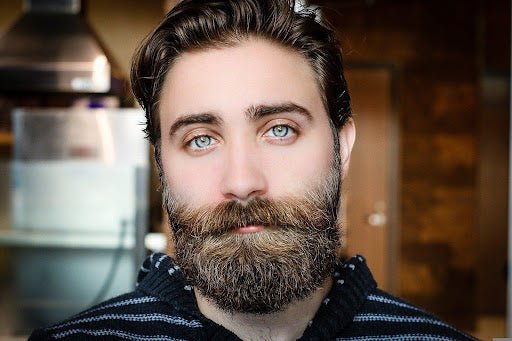A beard can be an exceptionally attractive feature of a man's face, but it doesn't come without challenges. Though the goal is to have a full and well-groomed beard, you may be plagued by skin issues like acne, bumps, ingrown hair, and dandruff. You may also find that your beard doesn't grow as full as you might like. Here, we'll discuss these conditions and the best solutions for fixing them.
Related: The Most Popular Beard Growth Kits of 2022
Dandruff in Your Beard
More than simply dry skin, dandruff is called seborrheic dermatitis, and it can exist on the skin under your beard. It can look as though you've got crumbs in your beard or that it isn't clean, but we know this isn't the case. Although we don't understand all the reasons why dandruff occurs, one of them may be a yeast called Malassezia. This, and other yeasts, can cause dandruff in your eyebrows, mustache, nose, scalp, and groin as well.
Solution
You can try a regular dandruff shampoo with 1% ketoconazole. This may or may not completely clear up your dandruff, but either way, you will need to be patient. It will take time. Other ingredients like selenium sulfide and pyrithione zinc may also help effect a change.
Even after your dandruff disappears, don't stop using whatever product or process you used to make it happen. Dandruff has a habit of reappearing when you stop treatment.
Just as important as knowing what to do, is knowing what not to do. In fighting dandruff, never use petroleum jelly (or similar compounds) to fix the appearance of dandruff. It doesn't actually make it disappear and can make your condition worse.
Beard Acne
We already know what acne is, but it can be especially irritating when it occurs under your beard. It happens when oils, dead skin cells, and bacteria are trapped on your skin and clog your pores.
Related: How to Grow a Beard Faster With These Simple Steps
Solution
Try not to touch your face. When you do, you transfer all the dirt and bacteria on your hands to your face. This often leads to acne breakouts. Then establish a daily routine of the following:
- Keep your face clean by washing it twice daily with a gentle cleanser containing acne-fighting glycolic acid or salicylic acid. Ensure you don't use harsh soaps that irritate your skin and worsen the acne.
- Rinse the cleanser thoroughly, so no chemical is left to irritate your skin.
- Use a clean towel to blot your face dry.
- Then carefully apply your acne treatment that contains benzoyl peroxide, salicylic acid, or a retinoid.
- Finally, groom your beard with a little beard conditioner (not oil). This will prevent your skin under the beard from becoming dry and itchy.
Getting rid of acne can take time, but consistent, careful treatment will yield results. Try a new treatment if one treatment won't work to diminish some of the acne after about a month.
Are you growing a beard? We can help you grow your beard healthier, faster, and fuller! Visit Beard Gains to learn more about our products.
Ingrown Hair
If you have curly, thick hair, you may find that you get ingrown hair in your beard. Ingrown hair begins when your beard is at the stubble stage when the hair first emerges from the follicles. Instead of growing out, some will turn and curl back into the skin. The result is red, painful, itchy bumps on your skin.
*Razors that raise the hair before cutting it may make the problem worse.
Solution
Don't think that shaving your beard will change anything - it won't. Shaving is when (and where) the problem begins. In the areas that you must shave, do so after you've showered. This will reduce the number of ingrown hairs. Also, use a pre-shave oil before applying unscented shave cream. When you've finished shaving, use post-shave moisturizer.
Remember to use a new razor or a shave guard on your electric razor to prevent shaving too close to your skin. Any process that allows you to shave closer to your skin will increase the chances of ingrown hair.

Patchy Beard Growth
Although it might seem like growing a beard is a straightforward process, this isn't the case for everyone. You might find that your beard has areas where the growth and density aren't consistent.
If you once had a full beard and suddenly spots develop, it may result from age-related hair loss or alopecia areata (autoimmune disease). In either situation, you may visit a dermatologist to see what can be done. There may be treatments or drugs you can try.
Itchy Beard Remedies
One of the most significant issues for men with beards is itchiness. Here are some natural remedies for itchy beards.
Keep Your Face Clean
Take regular baths or showers, and wash your beard and face to stop bacteria, dirt, and oil from building up on your skin. Use beard-specific products.
Condition Your Beard
Similar to conditioning the hair on your head, conditioning your beard will make it softer and less prone to irritating your skin. You can also use a light oil on your beard to keep it conditioned.
Avoid Chemicals
Avoid using products with harsh chemicals. Ensure that any washes, lotions, or foams you use are gentle with natural ingredients.

Related: The Best Ways To Get Rid of Beard Dandruff
Why Your Beard is Itching
A beard can be as challenging as it is attractive - especially if you're a new beard wearer. Proper hygiene and beard care can prevent some of the skin issues that can occur. For the other conditions, consider visiting a dermatologist for advice and medical guidance.
Do you need high-quality beard products? Our products are hand made, organic, and manufactured by women. Visit Beard Gains to learn more.
